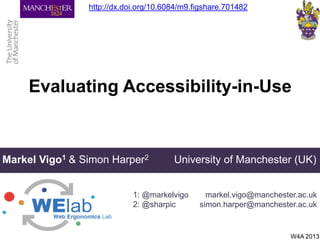Evaluating Accessibility-in-Use
- 1. Evaluating Accessibility-in-Use Markel Vigo1 & Simon Harper2 University of Manchester (UK) 1: @markelvigo 2: @sharpic W4A 2013 markel.vigo@manchester.ac.uk simon.harper@manchester.ac.uk http://dx.doi.org/10.6084/m9.figshare.701482
- 2. Evidence Guidelines cover around 53% of the problems encountered by users Power et al. 2012 Guidelines are only half of the story: accessibility problems encountered by blind users on the web CHI 2012, 433-442 W4A 201313 May 2013 2
- 3. Problem The perception of users about accessibility barriers is difficultly measurable and generalisable W4A 201313 May 2013 3
- 4. Paradox ŌĆō Some barriers are not perceived ŌĆō Some barriers are encountered but overcome ŌĆō Barrier free pages can cause a great hindrance W4A 201313 May 2013 4
- 5. Accessibility-in-use ŌĆ£the effects that real accessibility problems have on the quality of interaction as perceived by real users when interacting with real pages for achieving real goalsŌĆØ Vigo and Brajnik, 2011 Automatic web accessibility metrics: where we are and where we can go Interacting with Computers 23 (2), 137-155 W4A 201313 May 2013 5
- 6. What do we propose: Step 1. Observation & Identification of Coping Strategies 6 1. Observation W4A 201313 May 2013 Cognitive markers that indicate problematic situations
- 7. What do we propose: Step 2. Development of algorithms to detect strategies 7 1. Observation 2. Algorithms W4A 201313 May 2013
- 8. What do we propose: Step 3. Deployment in the wild 8 1. Observation 2. Algorithms 3. Deployment W4A 201313 May 2013
- 9. Case study Step 1. Observation and analysis ŌĆó 2 independent studies/datasets generated from ethnographic studies and user tests ŌĆó 24 screen reader and screen magnifier users ŌĆó 17 coping strategies were identified 9 W4A 201313 May 2013
- 10. Case study Step 2. Implement algorithms ŌĆō Asking for assistance ŌĆō Impulsive clicking ŌĆō Exploration tactics ŌĆō Narrowing down search ŌĆō Gaining orientation ŌĆō Re-doing ŌĆō Not operating ŌĆō Giving up 10 W4A 201313 May 2013
- 11. 11 WebTactics t1(){ .. } DB User Website Manager /Researcher 1.1 Detection algorithms are injected onto web pages. 1.2 Each algorithm keeps track of determined sequences of events and actions. 3. This event is asynchronously sent to a remote location. 2. When the use of a tactic is detected a notification is triggered. 4. Reports from users are viewed by interested parties. ti(){ .. } tn(){ .. } id timestamp URL tactic ccgu1331569030153 1333922552190 http://www.bbc.co.uk/sport/ t5 ccgu1331569030153 1333922556391 http://www.bbc.co.uk/sport/ t1 W4A 201313 May 2013 Case study Step 3. Deployment: WebTactics
- 12. Contributions ŌĆó A method to observe accessibility-in-use ŌĆó Our approach allows to capture the problems that emerge in the wild ŌĆó WebTactics W4A 201313 May 2013 12
- 13. Follow up 13 Contact @markelvigo | markel.vigo@manchester.ac.uk Presentation DOI http://dx.doi.org/10.6084/m9.figshare.701482 Source code https://bitbucket.org/mvigo/cope W4A 201313 May 2013













